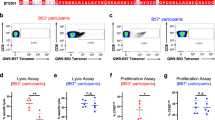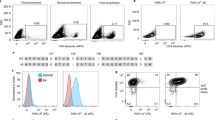Abstract
Cytotoxic T lymphocytes (CTL) recognize protein antigens which have been processed by the target cell and then presented in association with the relevant class I molecule of the major histo-compatibility complex (MHC)1. Short synthetic peptides, which are able to associate directly with target cells1, may substitute for these processed fragments in stimulating antigen-specific CTL responses. Using this approach, a dominant HLA-A2-restricted epitope has previously been mapped to residues 58-68 of influenza A virus matrix protein2. Here we report HLA-A2-restricted CTL which are also able to recognize this short synthetic peptide in association with HLA-Aw69, but which fail to recognize HLA-Aw69 expressing cells infected with influenza A virus. Furthermore, individuals possessing HLA-Aw69 who respond to influenza A virus, do not respond to M58—68. These results imply that the low response to this epitope on infection of HLA-Aw69 individuals with influenza A is due to failure of the naturally processed product of matrix protein to associate with Aw69.
This is a preview of subscription content, access via your institution
Access options
Subscribe to this journal
Receive 51 print issues and online access
$199.00 per year
only $3.90 per issue
Buy this article
- Purchase on Springer Link
- Instant access to full article PDF
Prices may be subject to local taxes which are calculated during checkout
Similar content being viewed by others
References
Townsend, A., Bastin, J., Gould, K. & Brownlee, G. Nature 324, 575–577 (1986).
Gotch, F., Rothbard, J., Howland, K., Townsend, A. & McMichael, A. Nature 326, 881–882 (1987).
Nomenclature for Factors of the HLA System, 1987 Immunogenetics 28, 391–398 (1988).
McMichael, A., Gotch, F., Santos-Aguado, J. & Strominger, J. Proc. natn. Acad. Sci. U.S.A. 85, 9194–9204 (1988).
Gammon, G. et al. Immunol. Rev. 98, 53–75 (1987).
Vidovic, D. & Matzinger, P. Nature 336, 222–226 (1988).
Holmes, N. & Parham, P. EMBO J. 4, 2849–2854 (1985).
Bjorkman, P. et al. Nature 329, 506–512 (1987).
Bjorkman, P. et al. Nature 329, 512–518 (1987).
Wallace, L., Kennedy, L., Landon, C., Bodmer, J. & Rickinson, A. Tissue Antigens 27, 298–307 (1986).
Murre, C. et al. J. exp. Med. 160, 167–178 (1984).
Allen, H., Wraith, D., Pala, P., Askonas, B. & Flavell, R. Nature 309, 279–281 (1984).
Stroynowski, I. et al. Immunogenetics 20, 141–154 (1984).
Arnold, B. et al. Cell 38, 79–87 (1987).
Carbone, F., Moore, M., Sheil, J. & Bevan, M. J. exp. Med. 167, 1767–1779 (1988).
Moore, M., Carbone, F. & Bevan, M. Cell 54, 777–785.
Brett, S., Cease, B. & Berzofsky, J. J. exp. Med. 168, 357–373 (1988).
McMichael, A. & Askonas, B. Eur. J. Immun. 81, 705–711 (1978).
Author information
Authors and Affiliations
Rights and permissions
About this article
Cite this article
Bodmer, H., Gotch, F. & McMichael, A. Class I cross-restricted T cells reveal low responder allele due to processing of viral antigen. Nature 337, 653–655 (1989). https://doi.org/10.1038/337653a0
Received:
Accepted:
Issue Date:
DOI: https://doi.org/10.1038/337653a0
This article is cited by
-
Molecular analysis of the association of HLA-B53 and resistance to severe malaria
Nature (1992)
-
Virus-induced autoantibody response to a transgenic viral antigen
Nature (1990)
-
Isolation of an endogenously processed immunodominant viral peptide from the class I H–2Kb molecule
Nature (1990)
-
Anti-HLA-A2 antibody-enhancement of peptide association with HLA-A2 as detected by cytotoxic T lymphocytes
Nature (1989)
-
Direct binding of influenza peptides to class I HLA molecules
Nature (1989)
Comments
By submitting a comment you agree to abide by our Terms and Community Guidelines. If you find something abusive or that does not comply with our terms or guidelines please flag it as inappropriate.



